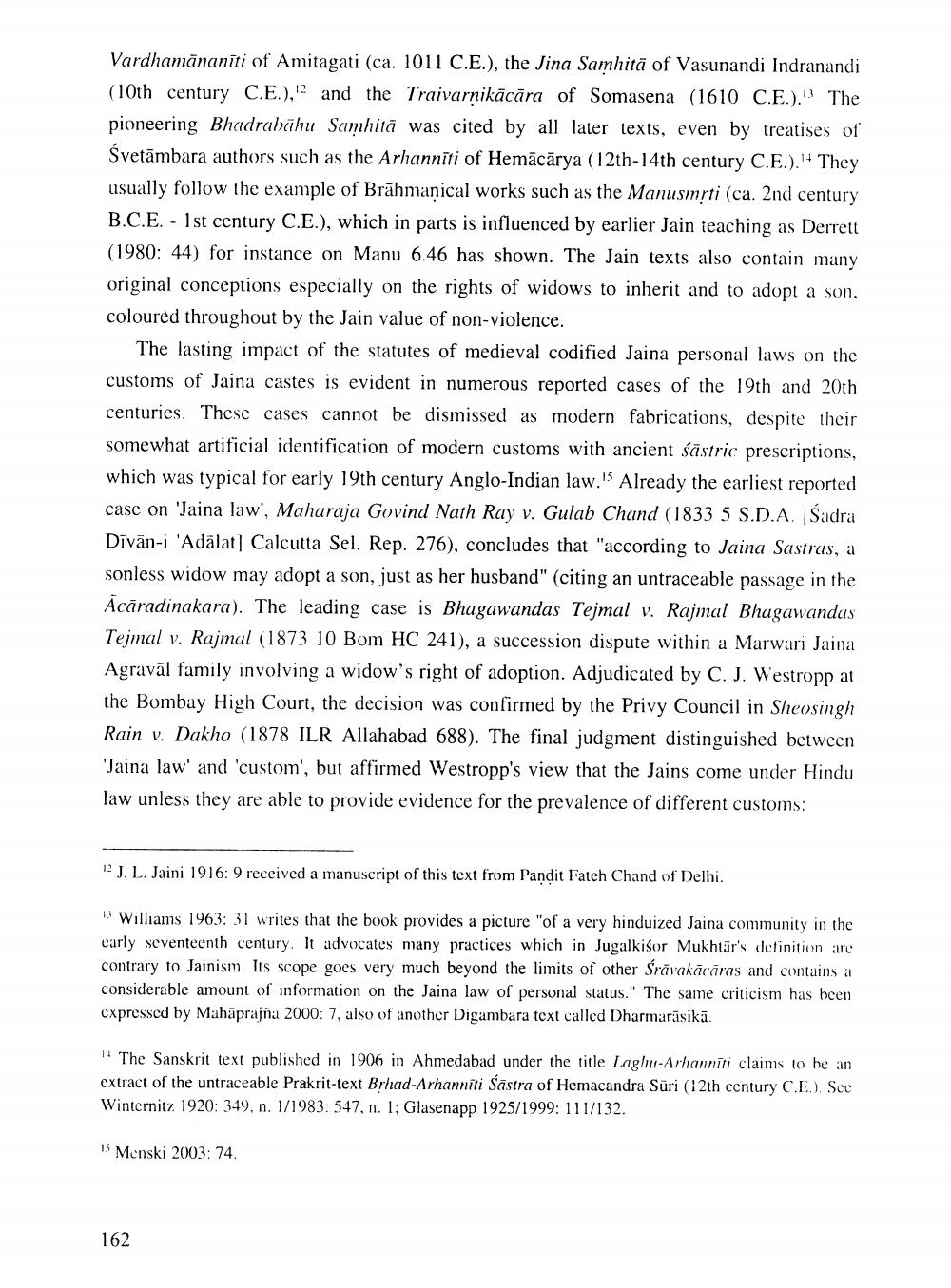________________
Vardhamananiti of Amitagati (ca. 1011 C.E.), the Jina Samhita of Vasunandi Indranandi (10th century C.E.), and the Traivarnikäcära of Somasena (1610 C.E.)." The pioneering Bhadrabahu Samhita was cited by all later texts, even by treatises of Svetämbara authors such as the Arhanniti of Hemācārya (12th-14th century C.E.). They usually follow the example of Brahmaṇical works such as the Manusmṛti (ca. 2nd century B.C.E. 1st century C.E.), which in parts is influenced by earlier Jain teaching as Derrett (1980: 44) for instance on Manu 6.46 has shown. The Jain texts also contain many original conceptions especially on the rights of widows to inherit and to adopt a son. coloured throughout by the Jain value of non-violence.
The lasting impact of the statutes of medieval codified Jaina personal laws on the customs of Jaina castes is evident in numerous reported cases of the 19th and 20th centuries. These cases cannot be dismissed as modern fabrications, despite their somewhat artificial identification of modern customs with ancient sastric prescriptions, which was typical for early 19th century Anglo-Indian law." Already the earliest reported case on 'Jaina law', Maharaja Govind Nath Ray v. Gulab Chand (1833 5 S.D.A. [Sadra Dīvān-i 'Adalat] Calcutta Sel. Rep. 276), concludes that "according to Jaina Sastras, a sonless widow may adopt a son, just as her husband" (citing an untraceable passage in the Acaradinakara). The leading case is Bhagawandas Tejmal v. Rajmal Bhagawandas Tejmal v. Rajmal (1873 10 Bom HC 241), a succession dispute within a Marwari Jaina Agraval family involving a widow's right of adoption. Adjudicated by C. J. Westropp at the Bombay High Court, the decision was confirmed by the Privy Council in Sheosingh Rain v. Dakho (1878 ILR Allahabad 688). The final judgment distinguished between Jaina law' and 'custom', but affirmed Westropp's view that the Jains come under Hindu law unless they are able to provide evidence for the prevalence of different customs:
-
12 J. L. Jaini 1916: 9 received a manuscript of this text from Pandit Fateh Chand of Delhi.
13 Williams 1963: 31 writes that the book provides a picture "of a very hinduized Jaina community in the early seventeenth century. It advocates many practices which in Jugalkisor Mukhtar's definition are contrary to Jainism. Its scope goes very much beyond the limits of other Śrāvakācāras and contains a considerable amount of information on the Jaina law of personal status." The same criticism has been expressed by Mahaprajña 2000: 7, also of another Digambara text called Dharmarasikā.
The Sanskrit text published in 1906 in Ahmedabad under the title Laghu-Arhanniti claims to be an extract of the untraceable Prakrit-text Brhad-Arhanniti-Sastra of Hemacandra Suri (12th century C.E.). See Winternitz 1920: 349, n. 1/1983: 547, n. 1; Glasenapp 1925/1999: 111/132.
15 Menski 2003: 74.
162




